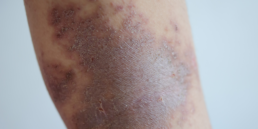CONTACT DERMATITIS
Contact dermatitis is a skin condition. It occurs when a substance comes into contact with the skin and triggers inflammation. Contact dermatitis is either an allergic or an irritant reaction.
The main symptoms of contact dermatitis are as follows:
- Skin rash
- Itching
- Dry skin
The rash only appears where the skin has had direct contact with the substance. Contact dermatitis most commonly affects the hands, as they’re more exposed to foreign substances than other parts of the body. The skin reaction may include redness, swelling, or even blisters. It generally appears 12-48 hours after contact with the substance.
CAUSES AND TRIGGERS
Contact dermatitis can be triggered by allergens or irritants.
The majority of cases are irritant contact dermatitis. A substance irritates the skin, breaking through its protective barrier and causing damage. The following products most frequently cause skin irritations:
- Soaps and detergents
- Chemical products (e.g., products used in the workplace)
- Creams
- Diapers
Allergic contact dermatitis is triggered by an immune response. The immune system perceives the substance as an attacking enemy and tries to fend it off, causing inflammation.
The following substances most frequently cause allergic reactions:
- Plants
- Metals (e.g., nickel in certain jewelry, cobalt)
- Perfumes and scented products (e.g., shampoos, soaps)
- Latex
- Cosmetics
- Certain medications
In both types of contact dermatitis, the skin may become inflamed upon initial contact or after prolonged exposure to the substance.
TREATMENT
Treating contact dermatitis involves finding and eliminating the source of the inflammation. As long as you’re exposed to the irritant or allergen, the redness and itching will persist. Symptoms generally disappear 1 to 3 weeks after your last exposure to the substance. If eliminating the source of the inflammation is impossible, you can try to limit your exposure (e.g., by wearing gloves at work).
Cortisone creams are often prescribed to treat dermatitis. Cold compresses can also be applied to relieve itching. In more severe cases, oral medications may be necessary.
WHEN SHOULD I SEE A HEALTH CARE PROFESSIONAL?
Speak with your health care provider if you develop any of the following symptoms:
- Severe itching
- A swollen rash, with or without blisters
- Signs of infection (e.g., fever, heat around the affected area, increased redness, pain)
FOR MORE INFORMATION:
Canadian Centre for Occupational Health
ECZEMA
Eczema, also known as atopic dermatitis, is a chronic skin problem that causes dry, itchy, scaly, red skin on various areas of the body.
It is sometimes accompanied by a secondary bacterial infection, darkening of the skin around the eyes and/or an extra fold of skin under the eye. In more severe cases, blisters and fissures may develop, and the skin may become thicker from repeated scratching.
Eczema usually begins during childhood, often improves with age, and appears to have a genetic component.
CAUSES AND TRIGGERS
In most cases, eczema is caused by an abnormality in the skin’s protective barrier. As a result, the skin becomes dehydrated more easily, and lacks adequate protection from allergens, microbes and irritants, causing itching. As for the visible skin lesions, they are a direct result of itching.
Individuals with eczema are often genetically predisposed to the condition and tend to suffer from atopy, a syndrome that causes allergies (food and/or environmental), asthma and chronic conjunctivitis, among other things. However, contrary to popular belief, eczema flares in children are rarely associated with food allergies.
Certain factors may trigger eczema flares, including:
- Cold or dry air
- Sweating
- Stress or anxiety
- Rapid temperature changes
- Exposure to certain chemical products (soap, detergents, perfumes, etc.)
- Wearing garments made of wool or synthetic fibers such as polyester
- Allergens
TREATMENT
Since eczema is a chronic condition, symptoms may worsen then improve periodically. While some people can go years without having any symptoms, eczema is not curable. To decrease the itch intensity and prevent new flares, it is important to keep the skin hydrated.
Here are a few tips:
- Avoid triggers.
- Keep fingernails short and clean and wear cotton gloves as needed to prevent scratching and secondary infections.
- To relieve itching, take short, lukewarm baths and use mild soap (e.g., Cetaphil) sparingly.
- Bath products (oils and others) have not been found to relieve symptoms.
- Long or hot baths should be avoided since they tend to dry out the skin.
- Bath salts should also be avoided.
- Apply a thick moisturizing cream (e.g., Eucerin) or ointment (e.g., Vaseline) liberally over the entire body at least twice daily, ideally immediately after bathing.
- Apply a dampened cotton dressing (e.g., gauze) to the affected area for a few days and change to a fresh dressing every eight hours.
Babies who have a parent, brother, or sister with eczema have a higher risk of developing eczema. Applying moisturizing creams or ointments (see above) on the baby’s skin daily from the first week of life may prevent eczema during the child’s first year. However, it is uncertain whether this is effective at preventing eczema later in life.
WHEN SHOULD I SEE A MEDICAL PROFESSIONAL?
- If the condition does not improve with treatment.
- If the face or skin folds are affected.
- If you believe another condition may be responsible for the symptoms.
FOR MORE INFORMATION:
Canadian Dermatology Association
Free delivery on prescriptions and medical supplies.
We offer free local delivery, curbside pick-up, and Canada wide shipping.

